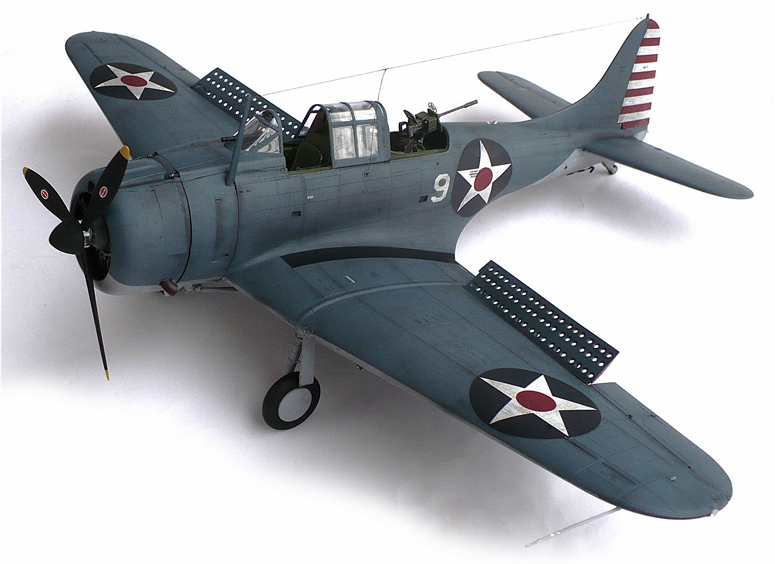From Wikipedia"
The Douglas SBD Dauntless was a World War II American naval scout plane and dive bomber that was manufactured by Douglas Aircraft from 1940 through 1944. The SBD ("Scout Bomber Douglas") was the U.S. Navy's main carrier-borne scout plane and dive bomber from mid-1940 through mid-1944. The SBD was also flown by the U.S. Marine Corps, both from land air bases and aircraft carriers. The SBD is best remembered as the bomber that delivered the fatal blows to the Japanese carriers at the Battle of Midway in June 1942.
During its combat service, the SBD was an excellent naval scout plane and arguably the world's best dive bomber. It possessed long range, good handling characteristics, maneuverability, potent bomb load capacity, great diving characteristics, defensive armament and ruggedness. In most of these characteristics, the SBD was superior to the German Junkers Ju 87, the Japanese Aichi D3A "Val", and any dive bomber possessed by the Royal Air Force or the Soviet Air Force. A variant was a purpose-built design for the U.S. Army Air Forces, which used the SBD without an arrestor hook as the A-24 Banshee.
Design work on the Northrop BT-1 began in 1935. In 1937, the Northrop Corporation was taken over by Douglas, and the active Northrop projects continued under Douglas Aircraft Corporation. The Northrop BT-2 was developed from the BT-1 by modifications ordered in November 1937, and provided the basis of the SBD, which first entered service in mid-1939. Ed Heinemann led a team of designers who considered a development with a 1,000 hp (750 kW) Wright Cyclone engine. One year earlier, both the U.S. Navy and Marine Corps had placed orders for the new dive bomber, designated the SBD-1 and SBD-2 (the latter had increased fuel capacity and different armament). The SBD-1 went to the Marine Corps in late 1940, and the SBD-2 to the Navy in early 1941. The distinctive perforated split flaps or "dive-brakes" had been incorporated into the BT-1 to eliminate tail buffeting during diving maneuvers.
The next version was the SBD-3, which began manufacture in early 1941. It had increased armor, self-sealing fuel tanks, and four machine guns. The SBD-4 provided a 12-volt (up from 6-volt) electrical system, and a few were converted into SBD-4P reconnaissance aircraft.
The next (and most produced) version, the SBD-5, was produced mostly in the Douglas plant in Tulsa, Oklahoma. This version was equipped with a 1,200 hp (890 kW) engine and an increased ammunition supply. Over 2,400 of these were built. A few of them were shipped to the Royal Navy for evaluation. In addition to American service, the SBD saw combat against the Japanese Army and Navy with No. 25 Squadron of the Royal New Zealand Air Force—but the RNZAF soon replaced them with the larger, faster, heavier and land-based Vought F4U Corsair.
Some SBDs were also flown by the Free French Air Force against the Nazi German Wehrmacht and Luftwaffe. SBDs were also sold to Mexico.
The final version, the SBD-6, had more improvements, but its production ended during the summer of 1944.
The U.S. Army Air Force had its own version of the SBD, called the A-24 Banshee. It lacked the tail hook used for carrier landings, and a pneumatic tire replaced the solid tail wheel. First assigned to the 27th Bombardment Group (Light) at Hunter Field, Georgia, A-24s flew in the Louisiana maneuvers of September 1941. There were three versions of the Banshee (A-24, A-24A and A-24B) flown by the Army to a very minor degree in the early stages of the war. The USAAF used 948 of the 5,937 Dauntlesses built.








No comments:
Post a Comment